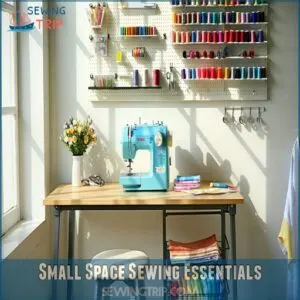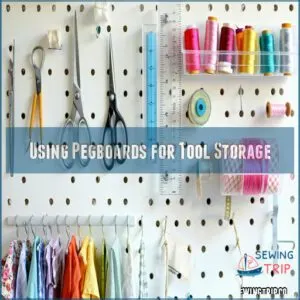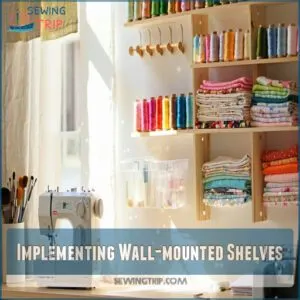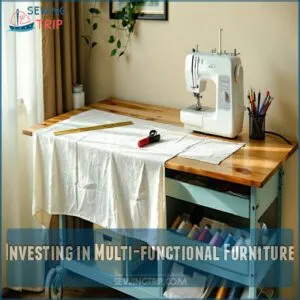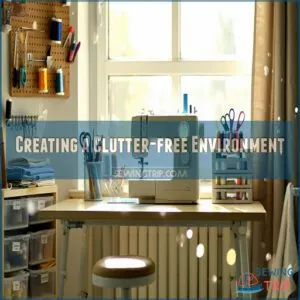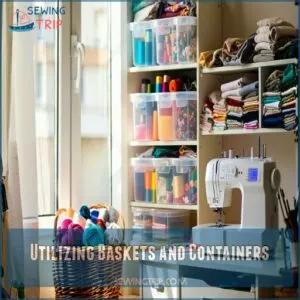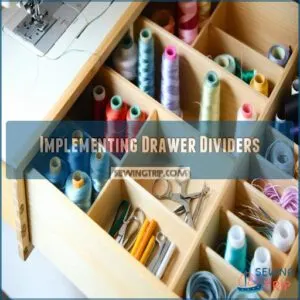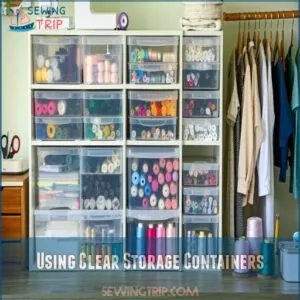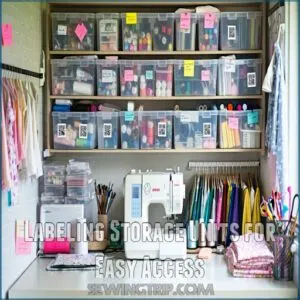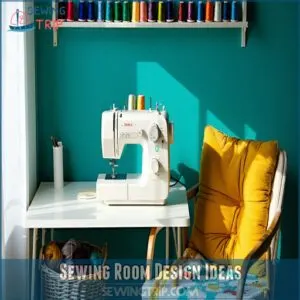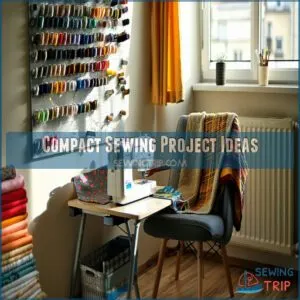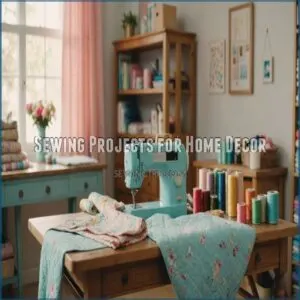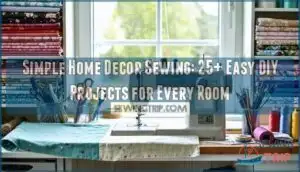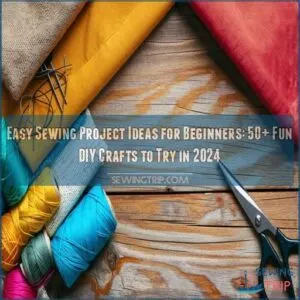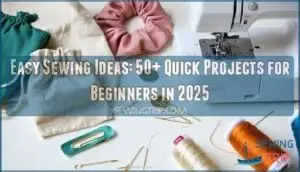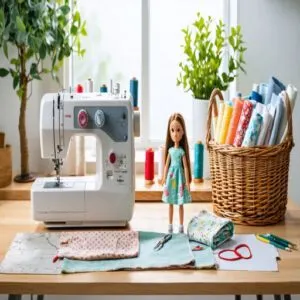This site is supported by our readers. We may earn a commission, at no cost to you, if you purchase through links.
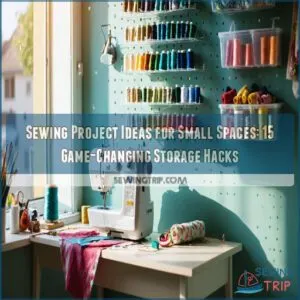
You’ll love how an L-shaped table transforms a corner into your personal design hub, while wall-mounted shelves and pegboards turn vertical space into a crafting goldmine.
Choose a lightweight sewing machine under 12 pounds with front-loading bobbins for easy access. Store fabrics using clear bins and rolling methods to maximize every inch.
Think of your compact sewing area as a cozy cockpit where everything’s within arm’s reach. The real magic happens when you discover how strategic storage frees unlimited creative potential.
Table Of Contents
Key Takeaways
- Maximize your space with vertical storage like pegboards, wall-mounted shelves, and hooks to keep tools and supplies organized and within easy reach.
- Choose compact, multifunctional furniture such as foldable tables or mobile trolleys to save space and increase flexibility in your setup.
- Organize supplies efficiently by rolling fabrics, using clear bins, and labeling everything to simplify access and maintain a clutter-free environment.
- Use a lightweight, portable sewing machine with space-saving features like front-loading bobbins to suit a small sewing nook.
Small Space Sewing Essentials
You’ll be amazed at how much sewing magic you can create in a tiny corner when you’ve got the right essentials at your fingertips.
Whether you’re working with a compact sewing machine on a fold-down table or maximizing vertical space with pegboards and wall storage, these smart solutions will help you turn even the smallest spot into your dream sewing station.
These smart solutions will utilize the space efficiently, and with the right tools, you can create a functional area, making the most of the available space to achieve your sewing goals, and make the most of your compact sewing machine.
Choosing The Right Sewing Table
When you’re setting up your sewing nook, choosing the right table can make or break your creative flow. A well-planned sewing desk isn’t just about table size – it’s about making every inch count in your small space.
Consider an L-shaped sewing table for corner optimization, or a compact desk that folds away when not in use. The right sewing table options can greatly impact your overall sewing experience.
- Look for tables with built-in storage compartments to maximize space efficiency
- Choose an ergonomic design that matches your height for comfortable marathon sewing sessions
- Consider tables with wheels for flexibility in rearranging your space
- Opt for adjustable-height surfaces to accommodate different sewing projects
Utilizing Vertical Storage Solutions
Your sewing space’s vertical real estate is like an untapped gold mine.
By installing wall-mounted shelves and pegboard hooks, you’ll transform those blank walls into organized storage havens.
Here’s a game-changing guide to maximize vertical space in small sewing areas.
| Solution Type | Space-Saving Impact | Best For |
|---|---|---|
| Wall Shelves | High | Fabric Storage |
| Storage Racks | Medium | Thread Organization |
| Pegboard Hooks | High | Tools & Notions |
| Foldable Units | Medium | Seasonal Items |
| Hanging Bins | High | Daily Supplies |
The provided table outlines various solutions with their space-saving impact and the type of items they are best suited for, offering a clear guide to help you decide on the most suitable options for your sewing space.
Selecting Compact Sewing Machines
When you’re working out of a cozy nook, choosing a compact sewing machine can make all the difference. A mini sewing machine with essential stitch options fits perfectly in small spaces while delivering the functionality you need.
To maximize the space, consider incorporating sewing room essentials into your setup.
- Look for machines under 12 pounds with built-in carrying handles
- Consider models with adjustable sewing speed controls
- Prioritize energy-efficient LED lighting features
- Select machines with front-loading bobbins to save space
- Choose portable options with protective dust covers
Organizing Sewing Supplies Efficiently
Efficiently transforming your tiny corner into a productive workspace starts with smart sewing supply storage.
You’ll need strategic organization to keep everything within arm’s reach. Here’s a game-changing table of storage solutions that’ll revolutionize your small sewing space:
| Storage Type | Best For | Space-Saving Tip |
|---|---|---|
| Pegboard Systems | Tools & Scissors | Install vertically behind machine |
| Thread Organizers | Spools & Bobbins | Mount on unused door space |
| Storage Bins | Fabric & Patterns | Use clear bins for visibility |
| Sewing Caddies | Daily Essentials | Choose rotating carousel style |
| Fabric Sorters | Current Projects | Roll instead of fold |
Effective sewing supply organization involves implementing a sewing room system to maximize space and productivity.
Maximizing Sewing Room Space
You’ll find that even the tiniest sewing corner can become a productive workspace with the right organization tricks and smart storage solutions.
With clever tools like pegboards, wall-mounted shelves, and multi-functional furniture, you can transform your compact sewing area into an efficient creative hub that keeps everything within arm’s reach.
Using Pegboards for Tool Storage
A pegboard’s honeycomb pattern transforms your cramped sewing nook into an organized haven.
You’ll love how tool hooks keep scissors, rulers, and measuring tapes at eye level, while sturdy storage bins cradle your thread spools and fabric scraps.
Mount this versatile grid anywhere – above your machine or beside your cutting table – to free up precious desk space and keep everything within arm’s reach.
Implementing Wall-mounted Shelves
Wall-mounted storage takes your sewing space to new heights, quite literally. You’ll love how these floating shelves free up precious floor space while keeping your supplies within arm’s reach.
By installing wall-mounted shelves strategically, you’re creating a vertical paradise for your crafting essentials.
- Mount adjustable shelves at varying heights for different-sized supplies
- Install foldable shelves that collapse when not in use
- Add clear acrylic wall-mounted thread holders for a sleek display
- Position shelves near your work area for easy access
- Use shelf dividers to create dedicated zones for fabrics, patterns, and tools
Investing in Multi-functional Furniture
Beyond wall shelves, your furniture choices can make or break a small sewing space.
A well-organized sewing space impacts productivity.
Consider a foldable table that doubles as a cutting station and workspace.
Space savers like modular desks with built-in storage units keep your supplies at arm’s reach while maximizing every inch.
Look for furniture hacks that transform ordinary pieces into sewing powerhouses – like turning a kitchen cart into a mobile sewing station.
Creating a Clutter-free Environment
Now that your multi-functional furniture is in place, let’s tackle the clutter that’s holding you back.
Start by adopting a minimalist storage approach – keep only what you use monthly. Sort supplies into clear containers, and create dedicated zones for different activities.
You’ll love how a clutter-free space transforms your sewing experience. Remember, an organized workspace isn’t just neat – it’s your ticket to faster, more enjoyable projects.
Effective sewing room organization techniques can also help you maximize your space and reduce clutter.
Sewing Storage Solutions
You’ll discover smart storage ideas that’ll transform your cramped sewing corner into an organized haven for all your crafting supplies.
From clear containers that let you spot your favorite fabrics at a glance to labeled drawer dividers that end the eternal "where’s my scissors" hunt, these storage solutions will help you make the most of every inch.
These storage solutions will help you make the most of every inch, by utilizing organized systems to keep your supplies in check.
Utilizing Baskets and Containers
Now that you’ve maximized your vertical space, let’s make those beautiful baskets and containers work harder for you.
You’ll love how fabric bins transform cluttered corners into Instagram-worthy storage spots.
Stack clear containers on shelf organizers to keep your notions visible and within reach.
Pop labels on everything – your sewing basket becomes command central when you can spot that perfect button in seconds.
Effective use of fabric storage can greatly enhance your sewing space organization with the help of clear containers.
Implementing Drawer Dividers
Drawer dividers are your secret weapon for taming the chaos of sewing supplies.
Install adjustable dividers to create custom compartments for threads, bobbins, and scissors.
You’ll love how easy it becomes to find your favorite needles when everything has its designated spot.
For tight spaces, try DIY cardboard dividers – they’re budget-friendly and perfect for organizing small sewing accessories in desk drawers.
Using Clear Storage Containers
Clear storage containers are your secret weapon for small sewing spaces.
You’ll love how transparent bins let you spot that perfect button or thread at a glance.
Mix different container sizes on your shelf organizers – use smaller ones for notions and larger bins for fabric stacks.
Add bin dividers to keep supplies sorted, and you’ll never waste time hunting for your measuring tape again.
Labeling Storage Units for Easy Access
Now that you’ve got your storage containers sorted, let’s make finding your supplies a breeze with smart labeling. Consider clear container storage to maximize visibility.
Your sewing storage solutions deserve more than hastily scribbled sticky notes. Create a cohesive label system that turns your space into an efficiency powerhouse.
With clear unit markers, you’ll never waste time hunting for that perfect button or elusive thread color again.
- Use color-coded organizer tags to group similar items (threads, buttons, zippers)
- Print waterproof access labels with large, easy-to-read fonts
- Create pictorial storage signs for quick visual reference
- Add QR code labels linking to detailed inventory lists
- Label both the front and top of stacked containers for visibility from any angle
Sewing Room Design Ideas
You’ll love how a well-designed sewing room can transform your crafting space from chaos to creativity, even in the tiniest corner of your home.
With smart color choices, practical lighting, and personal touches, you can create a cozy sewing sanctuary that’ll make every stitch feel like pure joy.
Selecting a Color Palette
Transform your sewing space into a creative sanctuary by choosing a color palette that energizes and inspires.
You’ll want harmonious hues that complement your sewing room decor without overwhelming the space.
Here’s a handy guide to popular color schemes and their effects:
| Color Scheme | Space Effect |
|---|---|
| Cool Blues | Calming, focused |
| Warm Neutrals | Cozy, inviting |
| Crisp Whites | Clean, spacious |
| Sage Greens | Natural, balanced |
Remember, light colors can make your space feel larger, while darker shades create intimacy in your minimalist design. Consider your fabric stash’s dominant colors to achieve space harmony.
Adding Decorative Elements
Now that you’ve set your ideal color scheme, let’s add personality to your sewing space with some Wall Decor that won’t cramp your style.
Display your favorite fabric rolls as Textile Art, turning storage into stunning visual elements. Pattern Mixing on accent walls creates depth without overwhelming the room.
- Hang vintage sewing patterns in floating frames for a nostalgic touch
- Create a gallery wall using your handmade projects as decorative accents
- Mount colorful fabric rolls on wooden dowels for a functional art installation
Incorporating Task Lighting
Beyond decorative touches, proper lighting can make or break your sewing experience.
Position an adjustable desk lamp near your machine to eliminate shadows while stitching. LED strips under shelves provide supplemental task lighting for detailed work.
Floor lamps offer flexibility when overhead light isn’t enough. Remember, you’ll want task lighting that’s bright but won’t strain your eyes during those late-night project sessions.
Creating a Cozy Atmosphere
While good lighting keeps you on task, making your sewing space cozy helps you stay inspired.
Add plush throw pillows and soft fabrics in calming colors to create a peaceful ambiance. Roll out a small area rug for warmth, and hang inspirational artwork that sparks creativity.
In compact sewing nooks, warm textures like woven baskets and knit storage bins make your space feel like a crafting sanctuary.
Compact Sewing Project Ideas
You don’t need a sprawling craft room to create beautiful sewing projects – your coffee table corner can work just as well with the right setup.
Whether you’re stitching up quick repairs or tackling ambitious quilts, we’ll show you clever ways to make every inch of your compact space work harder for your sewing adventures.
Utilizing Small Sewing Patterns
The beauty of small sewing patterns lies in their minimal space requirements.
You’ll find pattern scaling opens up endless possibilities – from crafting mini quilts to creating delicate tiny embroidery pieces.
For beginners, start with scraps of fabric to make charming sewing dolls or decorative accents.
These compact sewing ideas serve to maximize your limited workspace and help you master fundamental techniques without overwhelming your storage space, which is a key factor in the overall crafting experience.
Creating Portable Sewing Kits
Crafting a portable sewing kit transforms your on-the-go mending abilities into a superpower.
You’ll never be caught off guard with a loose button or torn seam again.
When designing your travel sewing companion, consider these essential components:
- Mini scissors, needles, and thread in neutral colors for versatile repairs
- Compact measuring tape and foldable fabric ruler
- Safety pins, straight pins, and a magnetic pin cushion
- Basic buttons and snaps for quick fixes
- Small thimble and seam ripper for precision work
A well-stocked portable kit also benefits from understanding portable sewing machines to enhance your sewing experience.
Implementing Space-saving Techniques
Through smart space-saving techniques, you’ll uncover hidden potential in your tiny sewing area.
Install folding tables that tuck away when not in use, and opt for stackable storage containers to maximize vertical space.
You’ll love how pegboards transform empty walls into organized tool stations.
Roll your fabrics instead of folding them, and use over-the-door organizers to keep your supplies within arm’s reach.
Making The Most of Limited Space
Even the tiniest spaces can become productive sewing nooks with smart storage hacks.
Transform corners into compact desks by using foldable solutions that tuck away when not in use.
You’ll maximize space optimization by storing supplies vertically and choosing small sewing projects that suit your area.
Keep frequently used items within arm’s reach, and consider wheeled storage that rolls under tables when you’re done sewing, to further enhance your sewing nooks.
Frequently Asked Questions (FAQs)
How do I design a sewing room for small spaces?
Maximize vertical space with pegboards and shelves for tools and fabrics.
Use compact furniture like foldable tables or trolleys.
Keep essentials organized in labeled containers, and let natural light brighten your cozy sewing nook.
What are the best sewing room ideas?
Think of your sewing room as a blank canvas—pegboards organize tools, compact desks save space, and natural light boosts creativity.
Add floating shelves, labeled bins, and cozy lighting to keep it functional yet inspiring!
How can I save space in my sewing room?
Use pegboards for vertical storage, roll fabrics to save space.
Add floating shelves for tools. Compact desks or foldable tables work wonders.
Keep frequently used items handy, and don’t underestimate portable trolleys!
Can a small room be used as a sewing room?
Funny how small spaces often make the coziest sewing rooms!
With vertical storage, compact furniture, and clever organization, you’ll transform any tiny room into a functional, inspiring sewing haven.
That’s big on creativity, not clutter.
How do you organize a small sewing room?
Organize your small sewing room by going vertical with pegboards, shelves, and wall hooks.
Sort tools into labeled containers, roll fabrics for space-saving storage, and keep essentials within arm’s reach.
For a clutter-free, efficient setup, ensure that all elements work together harmonically to enhance your sewing experience.
Can a tiny home be a sewing area?
Over 70% of tiny home owners prioritize multifunctional spaces, making it perfect for a sewing area.
Use vertical storage, compact tables, and portable trolleys to keep tools organized.
Natural light and task lighting are game-changers!
What can I sew in 30 minutes?
Whip up a quick tote bag, fabric coasters, or a simple drawstring pouch in 30 minutes.
These projects are perfect for using scraps, honing your skills, and adding a personal touch to everyday essentials, which can be perfect for using scraps.
What is the simplest thing to sew?
Did you know nearly 60% of sewing beginners start with scrunchies?
They’re quick, simple, and forgiving.
Grab some fabric, elastic, and thread—you’ll be stitching hair ties like a pro in no time!
How to set up a sewing room on a budget?
Create a sewing space on a budget by repurposing furniture, using pegboards for vertical storage, and labeling jars or baskets for organization.
Maximize natural light, embrace thrifted finds, and let creativity shape your setup, this will help you to have a well organized space.
Ensure to embrace thrifted finds and let creativity shape your setup.
What is the first thing a beginner should sew?
Starting sewing is like building a house—begin with a strong foundation.
Sew simple projects like pillowcases or tote bags.
They’re forgiving, teach straight stitches, and give you something practical to show off confidently!
Conclusion
A small sewing space doesn’t have to limit your creativity—it’s like fitting a whole orchestra into a single suitcase.
With smart storage hacks like pegboards, wall-mounted shelves, and compact sewing machines, you can transform any corner into a functional, inspiring sewing hub.
Keep sewing supplies organized with labeled bins, clear containers, and drawer dividers to maximize efficiency.
By focusing on sewing project ideas for small spaces, you’ll discover that great designs can happen in even the tiniest of areas.
- https://www.coralandco.com/blog/sewing-room-ideas-for-small-spaces-creative-space-saving-solutions.html
- https://www.instagram.com/p/CL32UvQJ6Pc/?igshid=MzRlODBiNWFlZA%3D%3D&img_index=2
- https://julesmadethis.wordpress.com/2018/03/04/sewing-room-make-over/
- https://theseamanmom.com/sewing-room-organization/
- https://abeautifulmess.com/emmas-home-office-tour/

